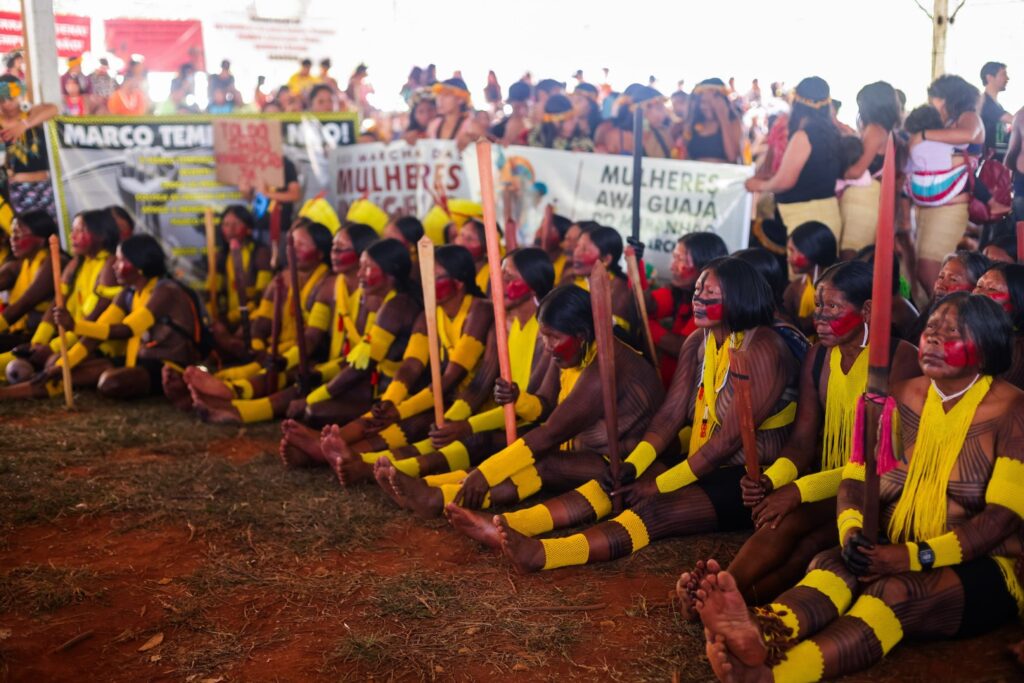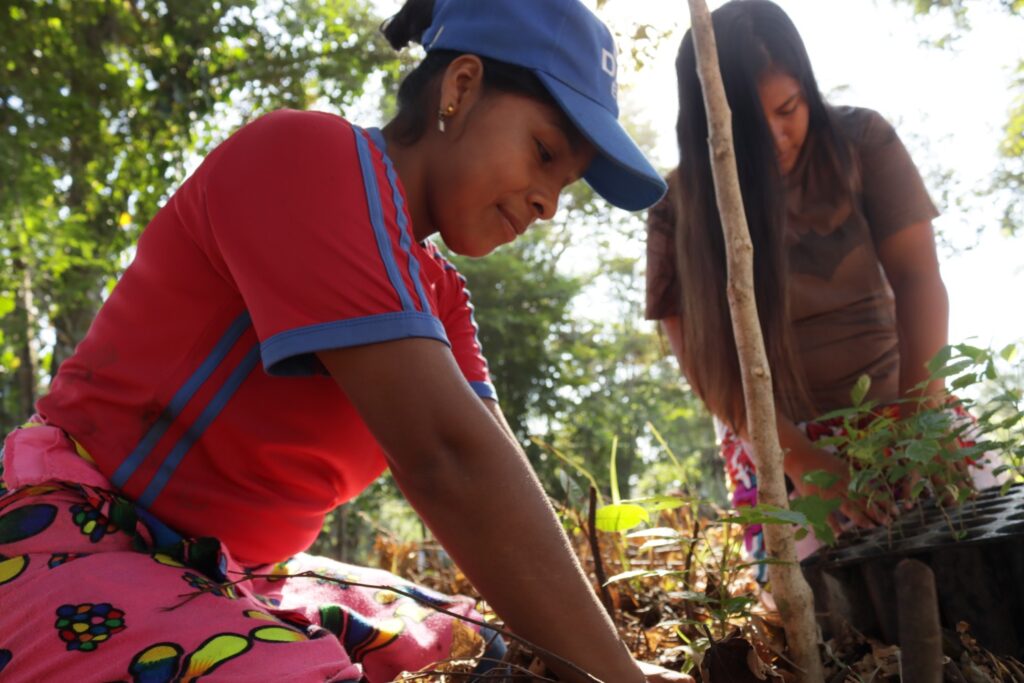November 02, 2023
From forest fires raging across North America, Europe and the Mesoamerican region, to a proliferation of tropical cyclones in Southeast Asia, humanity as a whole has undergone an unprecedented amount of climate related events this year. Due to their traditional roles as the primary caregivers in families and communities, and as the main providers of food and fuel, women are often more vulnerable when flooding, forest fires or drought occur, and often bear the brunt of their consequences. The UN estimates that 80% of those who have been displaced by climate change are women.
Perhaps it is because women are disproportionately affected by climate change and environmental issues that Indigenous and community women are joining forces globally to defend their rights and have their traditional knowledge recognized as part of the solution to the climate and environmental crisis. They are also increasingly conquering spaces of leadership at territorial, national and international levels in this regard. Women leaders in particular, like Sônia Guajajara and Célia Xakriabá have recently been elected to Brazilian Congress and have been pivotal in shifting policies, including fighting for a new bill to protect Indigenous women from violence.
While today marks the International Day for Violence Against Women and Girls, the nexus and relationship between environmental issues and violence against women is little explored. Last year’s iteration of the International Day in particular commemorated and payed homage to the Mirabal sisters, who were assassinated following their activism and opposition to the dictatorship of Rafael Trujillo in the Dominican Republic in the 1960s. Today, more than 50 years later, environmental activists are increasingly victims of gender-based violence. In Mexico and Central America, 609 aggressions against Women Environmental Human Rights Defenders were recorded between 2015 and 2016 (source: IUCN).

The III Indigenous Women’s March took place from September 11th to 13th 2023, in Brasilia, with the aim of connecting and reconnecting the potential of ancestral voices. The ending of violence against women was one of the event’s core messages. Credit: Kamikia KisedjeAPIB
Furthermore, according to recent IUCN research, as women’s and girls’ involvement in activism and political demonstrations in defense of the environment increases, so too do incidents of gender-based violence against them, often as a tactic of intimidation and silencing. Additionally, environmental degradation itself is a driver of gender-based violence. Resource scarcity, conflicts, and displacement caused by environmental degradation deepen existing inequalities. Gender-based violence is often used as a means of reinforcing privileges and control over resources.
Here are three reasons it is essential to dive deeper, better understand and pay more attention to the links between gender-based violence and the environment:
Indigenous and community women and girls are victims of increasing levels of physical and sexual violence. In particular, the expansion of markets in rural communities not only aggravates this situation by facilitating access to alcohol and drugs, but also progressively replaces handicrafts and food traditionally produced by women, thus deconstructing the Indigenous economy. In addition, the progressive degradation of the natural resources on which women depend for their subsistence, caused by climate change, the loss of biodiversity, and the pressure of extractive industries hamper their economic independence. When women decide to articulate their thoughts to address the violation of their rights, they are often excluded from decision-making processes both within communities and the organizations to which they belong.
The results of which show that 59% of women and 57% of men who responded to the survey had observed cases of gender-based violence while implementing environmental projects and initiatives. This goes beyond physical violence and includes psychological violence, which can often be more nefarious, in particular, 76% of women and 70% of men reported observing psychological violence against women. Physical violence was reported by 58% of female respondents and 70% of male respondents. Sexual violence was observed by 43% of women and 64% of men, and sexual harassment was reported by 40% of women and 55% of men.
https://youtu.be/eFuOguBknKo?si=rxHTBc_WSJc6cnW0 Sara Omi, Emberá lawyer, founder of the Emberá Artisan Women Association (AMARIE) and President of the Territorial Women Leaders of the Mesoamerican Alliance of Peoples and Forest (AMPB).
Despite the highly unequal conditions in which Indigenous and community women live, they are overcoming barriers, trailblazing and achieving historic levels of political articulation in South America, Mesoamerica, Indonesia, and Central Africa.
An example of this mass mobilization is that of the National Articulation of Indigenous Women Warriors of Ancestrality (ANMIGA), which has been coordinating the political activism of thousands of Indigenous women throughout Brazil since 2019. In February 2022, after several massive marches and awareness campaigns on the humanitarian crisis experienced by Indigenous Peoples, particularly women, as per above, ANMIGA co-founder Sonia Guajajara was placed as head of the country’s first Ministry of Indigenous Peoples.
In Mesoamerica, Indigenous Women are leading profound movements to revitalize cultural practices, ancestral agriculture, traditional medicine and forest management; which also strengthens local strategies for forest and water conservation, land regeneration, and adaptation to face climate change. These movements have achieved the creation of Traditional Medicine Centers and books, Cultural Homes for intergenerational learning, and networks of organic farmers and markets to promote economic and socio-cultural development from an indigenous concept.

Knowledge Weavers of the Women Association of Emberá Artisans (AMARIE) planting native trees to restore damaged land in Ipetí. AMARIE is an example of the regional movement for the empowerment of indigenous women through the revitalization of ancestral knowledge. Credit: Coordinator of Territorial Women Leaders of Mesoamerica
At the international level, Indigenous and forest community women from Latin America, Central Africa, and Indonesia are strengthening their political organization within the Global Alliance of Territorial Communities (GATC). At COP27, their participation was unprecedented, advocating for access to climate finance, as barely 1% reaches indigenous communities.
https://youtu.be/yp-WLMnTsjs?si=eI5rJdl6Me6gJpwo Women of the Global Alliance of Territorial Communities. Credit: Global Alliance of Territorial Communities and TINTA.
The political leadership of Indigenous and community women in climate change action and environmental restoration is expanding its frontiers in ways it hasn’t before. We hope and implore that the spheres of environmental action and activism can be a safe space for women to improve their own lives and the lives of their communities. We will continue our work and mission to ensure that this is the case.
TINTA is first and foremost a platform for facilitation and connection. We are alongside Indigenous and local community organizations, with a particular focus on the important role that women and youth play in protecting ecosystems, fighting climate change, and securing rights. Our work is strongly rooted in creating and supporting spaces for women to be able to carry out their missions in safety and security.
The Coordinator of Territorial Women Leaders (CMLT) is a space of dialogue, learning and joint action for Indigenous and community women leaders of the Mesoamerican Alliance of People and Forest (AMPB), a platform for frontline organizations that preserve forest and defend tenure rights from Mexico to Panama. CMLT recently launched its Gender and Climate Change Plan, where main strategic objectives where established to be: grassroots women empowerment, strengthening the productive capacities of territorial women and their communities, the promotion of ancestral knowledge, and direct and gender inclusive financing.